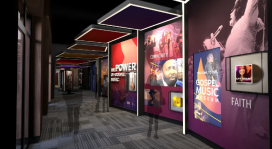
Images found on an ancient tablet reveals that the Tower of Babel was not mere fiction but was an actual massive structure that stood in Babylon. However, is it the same tower mentioned in the book of Genesis?
The tablet, which dates back to sixth century B.C., was discovered in Babylon more than 100 years ago, but because it was privately owned, it did not have a chance to be closely examined until now.
Dr. Andrew George, professor of Babylonian at the Department of the Languages and Culture of Near and Middle East at the SOAS University of London, interpreted the text and images on the tablet. His findings were featured in a series produced by the Smithsonian.
"This is a very strong piece of evidence that the Tower of Babel story in the Bible was inspired by this real building," George said.
He pointed to a step-like image of a tower near the top of the tablet. Below that image was text that translates as "the Ziggurat or Temple Tower of the city of Babylon."
The tablet gives the first evidence that shows how the Tower of Babel looked like. George's findings revealed that the structure was "a Mesopotamian stepped tower and illustrates the seven tiers of the ancient megastructure," the Smithsonian said.
On the right side of the tower's image was the figure of a man with a conical hat and carrying a staff. George identified him as King Nebuchadnezzar II. Based on inscriptions on the tablet, Nebuchadnezzar was the one who commissioned the tower's construction.
The ancient text also gave details on how the tower was built.
According to George, the text reads, "From the Upper Sea to the Lower Sea, the far-flung lands and teeming people of the habitations I mobilized in order to construct this building of the Ziggurat of Babylon."
The Upper Sea refers to the Mediterranean while the Lower Sea refers to the Persian Gulf.
Scholars said one important detail that links the Tower of Babel with the Bible was the discovery of a brick dating back from the time of Nebuchadnezzar that has a black substance on its side. Scientists identified the substance as bitumen, a tar mortar used in ancient times.
The biblical account in Genesis 11 mentions that the earth's inhabitants built the tower using "brick for stone, and bitumen for mortar."
George and other experts widely believe the account of the Tower of Babel was written during the Babylonian captivity when the Jews were exiled to Babylon by Nebuchadnezzar. According to theories, the Jews witnessed the construction of the tower while they were in captivity.
"I think ... the Jewish population exiled in Babylon in the sixth century B.C. by Nebuchadnezzar very likely utilized the tower as their inspiration for the Tower of Babel story in the Bible," Dr. Mark Altawell at the University College London said in an episode of the Smithsonian series.
"They may have seen it as a symbol of their oppression ... this large, looming building where they lived in this foreign city, a culture they didn't know very well, so I think it became symbolic to them," he added.
However, the biblical account of the construction of the Tower of Babel was set after the Great Flood. Genesis 11 says the inhabitants of the whole earth shared "one language and the same words." They migrated to the east, settled on the plain of Shinar and decided to build "a city and a tower with its top in the heavens."
The Bible says God saw what they were building and decided to confuse their language and disperse them all over the earth, or else "nothing that they propose to do will now be impossible for them." The Bible does not record that the tower was destroyed.
Answers in Genesis refutes the experts' claim that the Tower of Babel was found in Babylon. In an article titled 'Where in the World is the Tower of Babel,' Answers in Genesis says historical, geographical and geological analysis "shows that Shinar cannot have been in the south, but rather was a territory in what is northeastern Syria today."
"The Tower of Babel was most likely built in the Khabur River triangle of North Syria, somewhere inside a triangle marked at its points by Tell Brak, Tell Aqab (near Amuda) and Tell Fakhariyah; and could not have been located anywhere in southern Mesopotamia, as has been traditionally believed," Answers in Genesis says.
"There is a possibility that we may yet find the actual site of the Tower of Babel, but this will require further research as well as onsite archaeological excavation," it adds.







